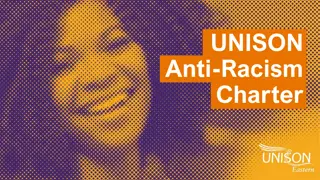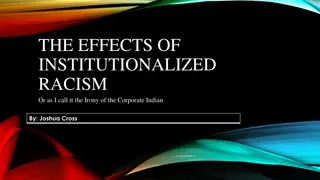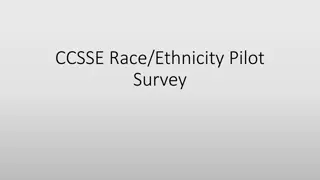Federal Public Service Equity and Anti-Racism Webinar
Explore topics such as employment equity, diversity, inclusion, anti-racism, and mental health in the Federal Public Service in this educational webinar series. The presentation delves into the importance of racial equity, anti-racism efforts, mental health support, and psychological safety in the workplace. The webinar also pays tribute to key individuals advocating for equity and inclusion. Discover the moral imperatives, governance obligations, and legal responsibilities related to equity and anti-racism. Various strategies and actionable steps to address racism and promote equality are discussed, along with the significance of tracking progress through operational data analysis.
Download Presentation

Please find below an Image/Link to download the presentation.
The content on the website is provided AS IS for your information and personal use only. It may not be sold, licensed, or shared on other websites without obtaining consent from the author.If you encounter any issues during the download, it is possible that the publisher has removed the file from their server.
You are allowed to download the files provided on this website for personal or commercial use, subject to the condition that they are used lawfully. All files are the property of their respective owners.
The content on the website is provided AS IS for your information and personal use only. It may not be sold, licensed, or shared on other websites without obtaining consent from the author.
E N D
Presentation Transcript
0.1 Equity, Anti Equity, Anti- -Racism and Mental Health in the Federal Public Service Racism and Mental Health in the Federal Public Service quit , antiracisme et sant mentale dans la fonction publique f d rale quit , antiracisme et sant mentale dans la fonction publique f d rale Federal Youth Network Webinar - Employment Equity, Diversity and Inclusion, Anti-Racism Series! Webinaire du r seau f d ral des jeunes - S rie sur l' quit en mati re d'emploi, la diversit et l'inclusion, l'antiracisme ! October 6, 2022 - 1:30 pm to 3:30pm EST 6 octobre 2022 13h30 15h30 HSE Dr. Martin Nicholas and/et Elisabeth (Liz) Martin
0.2 Disclaimer: The facts and opinions expressed in this presentation and on the following slides are solely those of the presenters. This webinar is intended to be a collective learning experience and a template or platform for advancing the work related Racial Equity, Anti-Racism, Mental Health and Psychological Safety. We are here in a spirit of service to and solidarity with the marginalized. Clause de non-responsabilit : "Les faits et les opinions exprim s dans cette pr sentation et sur les diapositives suivantes sont uniquement ceux des pr sentateurs. Ce webinaire est destin tre une exp rience d'apprentissage collectif et un mod le ou une plateforme pour faire avancer le travail li l' quit raciale, l'antiracisme, la sant mentale et la s curit psychologique. Nous sommes ici dans un esprit de service et de solidarit avec les personnes marginalis es."
Dedication of this Webinar 0.3 To: The Senator - Mr. Ian Shugart, the Retired Clerk of the Privy Council who issued the Clerk s Call to Action on Anti-Racism, Equity and Inclusion We congratulate him for being appointed by the Prime Minister as an Independent Senator His Call to Action is supported by s.15 of the Canadian Charters of Rights and Freedom TODAY we will be analyzing operational data as supporting evidence for undertaking the following Call to Action. We will refer to the other actions during the Webinar. Measuring progress and driving improvements in the employee workplace experience by monitoring disaggregated survey results and related operational data (for example, promotion and mobility rates, tenure) and acting on what the results are telling us.
0.4 Slogans for Equity and Anti-Racism Moral Imperative Governance Obligation Legal Responsibility
0.5 Outline of Presentation and Discussion Equity in the Federal Public Service is Substantive Equality as protected by the Charter Research and Analysis of Representation Data of Black Employees and the Employment Equity Designated Groups in the Public Service New Key Leadership Competency for Executives on Racial Equity and Anti- Racism Addressing the Cost of Racism on the Mental Health of Public Servants What we can do about it.
Unit 1 Section 15 of the Canadian Charter of Rights and Freedoms La Charte canadienne des droits et libert s Equality is not treating all equally 1.1 Equity is a means to Substantive Equality (d galit r elle) Equality in Opportunity Equality in Outcome Equality in Access How are we doing in 2022? Have we addressed the racially disadvantaged? Are we monitoring outcomes for subgroups such as Black employees?
1.2 What are the Main Takeaways? In Canada we do not have formal equality. We have substantive equality. So equality is not treating people the same. Equality is to use Equity to address and redress inequalities which include Racial Inequalities. 1. Disaggregated data in the Federal Public Service (since 2017) gives irrevocable evidence that Black Employees are the most stagnated and face the largest barriers to career advancement and entry into the EX cadre. ACTION Implement the Clerk s Call to Action for Black Employees. 2. We require leaders competent in Racial Equity and Anti-Racism. ACTION Add a Key Leadership Competency on Racial Equity and Anti-Racism for Executives. 3. Racism causes adverse effects on the Mental Health and Psychological Safety of Racialized Groups at a cost of Billions of Dollars. ACTION Add Anti-Racism to the National Standard for the Psychological Health and Safety for Canadian Workplaces.
Unit 1: Unit 1: Substantive Equality is NOT treating all the same 1.3 This is a violation of the Duty to Accommodate consistent with the Canadian Human Rights Act How do you establish a bona fide occupational requirement? Comment tablir une exigence professionnelle justifi e? The Supreme Court of Canada established a three-step process (Meiorin and Grismer cases, both in 1999) / La Cour supr me du Canada (arr ts Meiorin et Grismer, 1999) a tabli un processus comprenant les trois tapes : 1. It is connected to the performance of the job; 2. It is necessary to fulfill the work-related purpose; and 3. It is reasonably necessary to do the work.
Equity is a means to substantive Equality/ L' quit est un moyen d'atteindre une galit r elle 1.4 Remove Barriers e.g., EQUITY Program Address Barriers e.g., EQUITY Special Measures Retirer les barri res p. ex. Programme d quit S'attaquer aux obstacles p. ex., QUIT Mesures sp ciales
Purpose of the Employment Equity Act/ Purpose of the Employment Equity Act/ Objet sur l quit en mati re d emploi sur l quit en mati re d emploi Objet de la de la Loi Loi 1.5 2 The purpose of this Act is to achieve equality in the workplace so that no person shall be denied employment opportunities or benefits for reasons unrelated to ability and, in the fulfilment of that goal, to correct the conditions of disadvantage in employment experienced by women, Aboriginal peoples, persons with disabilities and members of visible minorities by giving effect to the principle that employment equity means more than treating persons in the same way but also requires special measures and the accommodation of differences. 2 La pr sente loi a pour objet de r aliser l galit en milieu de travail de fa on que nul ne se voie refuser d avantages ou de chances en mati re d emploi pour des motifs trangers sa comp tence et, cette fin, de corriger les d savantages subis, dans le domaine de l emploi, par les femmes, les autochtones, les personnes handicap es et les personnes qui font partie des minorit s visibles, conform ment au principe selon lequel l quit en mati re d emploi requiert, outre un traitement identique des personnes, des mesures sp ciales et des am nagements adapt s aux diff rences.
Data that affects Public Servants differently depending on their Race 1.6 Racial Discrimination in the Federal Public Service - Public Service Employee Survey 2020 Question 64a. Please indicate the type of discrimination you experienced. Race Black Employees 80% Response rates of those who said YES Visible Minority 62% Non-Visible Minority 12%
2.1 Unit 2 Unit 2: : Barriers to enter EX Cadre and Stagnation in the Federal Public Service A Comparison of Black Employees with EE Groups What does the data on representation tell us about equality in outcomes?
2.2 Use of a Disproportionality Index to identify deviation from a uniform distribution focus on the EX Cadre Consider the Representation percentage of Demographic Groups in the EX Cadre from 2017 to 2021. Table 1: Representation percentage of Demographic Groups in the EX Cadre from 2017 to 2021. Demographic Group BLACK Employees Visible Minorities Indigenous Peoples Persons With Disabilities Women 2017 1.4% 10.2% 3.9% 5.2% 48.0% 2018 1.4% 10.1% 3.7% 4.8% 49.1% 2019 1.6% 11.1% 4.1% 4.6% 50.2% 2020 1.6% 11.5% 4.1% 4.7% 51.1% 2021 1.9% 12.4% 4.4% 5.6% 52.3% From the data in the table above alone we cannot do the following i. ii. Cannot evaluate the change in representation from 2017 to 2021 iii. Cannor compare Data for the demographic groups Cannot determine if there is under-representation or over-representation;
2.3 Representation of Employees in Department X as of March 31, 2021 Number Percentage of Total In Department X % of members of Group A and B in the Canadian Population - From the 2021 Census Group Group A 20 4% 4% Group B 20 4% 4% All Employees 500 100% Not applicable The Representation of Group A and Group B match the % in the Canadian population. However, examination of Salary Level Representation reveals issues with stagnation and barriers to progress. The Next slide discusses this using illustrative data.
Disproportionality Index to compare groups Disproportionality Index to compare groups What is different between Groups A and B What is different between Groups A and B 2.4 Department X has 500 employees. Representation of Group A = 4%; and Group B = 4% ????????; ???????????? = % ????? ?;?????? ????? ? % ??? ?????????;?????? ????? ? Disproportionality INDEX A Percentage Distribution for ALL Group B with Stagnation and Barriers Group A with Good Career Progress Salary Range i B 20% 20% 0.25 Very High 1.00 5% High 1.00 20% 20% 0.75 15% Middle 1.25 1.00 20% 25% 20% 1.50 20% 1.00 Low 20% 30% 1.50 0.75 Very Low 20% 30% 15%
2.5 A Disproportionality Index (DI) A Disproportionality Index (DI)is a measure of a group s equitable distribution. The higher value of the index, the more overrepresented the group is compared to the representation in the reference population. DI values could be used to examine the representation of a group (e.g., Black employees) in the EX cadre or across salary ranges to find evidence for barriers to advancement or stagnation in lower levels. % Group X; EX Representation % All Employees; EX Representation Disproportionality Index (DI) for the EX Cadre Representation for X =
2.6 Table 2. Disproportionality INDEX (DI) for EX Cadre Representation for Black Employees in comparison to the DI values for EE Groups pursuant to the EE Act as of March 31st of the following Calendar Years Equity Group 2017 2018 2019 2020 2021 BLACK 0.50 0.48 0.50 0.46 0.50 Visible Minorities 0.68 0.64 0.66 0.65 0.66 Indigenous Peoples 0.75 0.73 0.80 0.80 0.85 Persons With Disabilities 0.95 0.91 0.88 0.90 1.00 Women 0.88 0.90 0.92 0.93 0.94 The Table 2 data shows the following: Under-representation: DI < 1 Change from 2017-2021: a) Blacks and VMs do not show improvement; b) Women show a steady improvement; and c) Indigenous Peoples also show improvement but remain under-represented Overall observation: The data is consistent with the premise that Blacks have been consistently the most under-represented in the EX Cadre. .
2.7 What should be done to address the Data from Table 2: 1. Use EE Act Special Measures to address this issue. Disaggregated data for EX cadre representation for Blacks has been available since 2017. 2. Implement, the Call to Action on Anti-Racism, Equity and Inclusion by the Clerk of the Privy Council Office, which has called for special measures for the Black EE Subgroup. i. Appoint employees to and within the Executive Group through career development and talent management ii. Sponsor high-potential employees to prepare them for leadership roles iii. Support the participation of employees in leadership development programs (for example, the Executive Leadership Development Program) and career development services (for example, official language training)
3.1 Unit 3 Unit 3: : Use of Disproportionality Indexes for Use of Disproportionality Indexes for Salary Range Representation to examine Salary Range Representation to examine Stagnation and Barriers to Career Stagnation and Barriers to Career Advancement Advancement for employees in the Federal Public Service in Canada as of March 31, 2021
Comparison of Representation of Black Employees with All Employees Comparison of Representation of Black Employees with All Employees 3.2 To get information whether stagnation and barriers to advancement exists the salary ranges were divided into FIVE approximately equal parts. From the very low range to the very high range. Overrepresentation at the very low range would indicate stagnation. Underrepresentation in the very high range would suggest barriers to carriers advancement. Salary range ($) All employees (20% 3%) Black Employees % of All employees Number Number % of All Blacks 16.7 Less than $60,000 (Very Low) 38,139 2077 23.5 17.6 $60,000 to $69,999 (Low) 40086 2089 23.9 23.1 $70,000 to $84,999 (Medium) 52843 1833 20.9 19.3 $85,000 to $99,999 (High) 44075 1376 15.7 23.3 Over $100,000K (Very High) 53202 1379 15.8 100 All ranges 228,345 8754 100
3.3 Disproportionality Index for Comparative Representation at different Salary Ranges from Very Low to Very High % Group X; Salary range i % All Employees; Salary range i = ????????; ???????????? ??Black employees; < 60K = 23.5% 16.7%= 1.41
3.4 Calculation of the Disproportionality Index for Salary Ranges of public service of Canada employees for Black, Visible Minority Group, Indigenous Peoples and Persons with Disabilities (as of March 31, 2021) The Disproportionality Index (DI) for a given range R for group DG = (% Representation of DG in Range R)/ (% Representation of DG for All Ranges) Disproportionality INDEX (DI) for Demographic Groups (DG) Members of a visible minority group 1.07 1.08 Percentage of All employees Indigenous Peoples Persons with Disabilities Non-VM Black Employees Salary range R ($) 1.41 1.13 0.98 Less than 60K 17% 1.37 1.12 1.08 1.11 0.97 60 to 70K 18% 0.92 0.95 1.06 0.91 1.01 70 to 85K 23% 0.82 0.97 1.15 1.00 1.01 85 to 100K 19% 0.68 0.93 0.73 0.95 1.02 Over 100 K 23% 0.58 0.71 0.67 1.02 1.07 Over 150K 2% 0.50 0.66 0.85 1.00 1.08 Executive Cadre ONLY 3% 1.0 1.0 1.0 1.0 1.0 All ranges 100% by definition by definition by definition by definition by definition
The Disproportionality Index for Salary Ranges of public service of Canada employees for Black, The Disproportionality Index for Salary Ranges of public service of Canada employees for Black, Visible Minority Group, Indigenous Peoples and Persons with Disabilities Visible Minority Group, Indigenous Peoples and Persons with Disabilities (as of 3.5 (as of March 31, 2021) March 31, 2021) Evidence for Stagnation Evidence for Systemic Barriers to Progress
Comparison of the Disproportionality Index for Salary Ranges of public service of Canada employees for Black, Visible Minority (VM) Group, Non-VM (as of March 31, 2021) 3.6 The Disproportionality Index (DI) for a given range R for group DG = (% Representation of DG in Range R)/ (% Representation of DG for All Ranges) Disproportionality INDEX (DI) for Demographic Groups (DG) Black Employees Members of a visible minority Non-VM Salary range R ($) group 1.07 1.42 0.98 Less than 60K 1.37 1.12 0.97 60 to 70K 0.92 0.95 1.01 70 to 85K 0.82 0.97 1.01 85 to 100K 0.68 0.93 1.02 Over 100 K 0.58 0.71 1.07 Over 150K 0.50 0.66 1.08 Executive Cadre ONLY 1.0 1.0 1.0 All ranges by definition by definition by definition
A Comparison of the Disproportionality Index for Salary Ranges of public service of Canada A Comparison of the Disproportionality Index for Salary Ranges of public service of Canada employees for Black and Non employees for Black and Non- -Visible Minority Group, Visible Minority Group, (as of 3.7 (as of March 31, 2021) March 31, 2021) Evidence for Stagnation Evidence for Systemic Barriers to Progress
3.8 Disproportionality Indexes for Salary Level Representation of Blacks, Visible Minorities (VM) & Non-Visible Minorities (non-VM) Disproportionality Index (DI) Values per Group 0 0.2 0.4 0.6 0.8 1.0 1.2 1.4 1.6 Evidence for Systemic Barriers to entering the EX Cadre DI =1.0 is the average Executive Cadre Representation DI << 1 for the EX Cadre & At Higher Salary Levels is evidence for Systemic Barriers to advancement 150,000 and above 100,000 and above 85,000 to 99,999 DI >> 1 at Lower Salary Levels Indicate Stagnation without career progression SALARY RANGE 70,000 to 84,999 60,000 to 69,999 Evidence for Stagnation below 60,000 All Non- Visible Minority Employees Visible Minority Employees BlackEmployees
RRDP Gear Connect 3.9 RECRUITEMENT RETENTION DEVELOPMENT PROMOTION RECRUITEMENT RETENTION Targeted recruitment of Black, Indigenous Peoples, VMs and PWDs . All employees, especially the racialized people need to feel that they are included and hence would want to stay . R R PROMOTION DEVELOPMENT P D Racialized employees stagnated should be developed, sponsored and promoted to the Executive Cadre as well.. Targeted development programs with mentorship and sponsorship is required. https://www.canada.ca/en/privy-council/corporate/clerk/call-to-action-anti-racism-equity-inclusion-federal-public-service.html https://www.canada.ca/fr/conseil-prive/organisation/greffier/appel-action-faveur-lutte-contre-racisme-equite-inclusion-fonction-publique-federale.html
Unit 4 Unit 4 - Enriching the Key Leadership Competencies (KLCs) for Executives by adding a new KLC for Racial Equity, Anti-Racism & Reconciliation 4.1 Shepherd Shepherd Racial equity & Anti- Racism Facilitate Facilitate Reconciliation
5.1 Unit 5 - Cost of Racism on the Mental Health and Psychological Safety of Canadians
5.2 Sph res de racialisation syst mique Spheres of Systemic Racialization Structurelle (G n ratrice de pr jug s, durable & cumulatif) Structural ( Bias-generating, Durable & Cumulative) Institutionnelle (Pr jug s dans les politiques et les pratiques) Institutional (Bias in policies & practices) Interpersonnelle (P jug s implicites envers des personnes sp cifiques) Interpersonal ( Implicit bias towards specific people) Int rioris e (Croyances des individus y compris la menace st r otyp e) Internalized (Beliefs within individuals including stereotypic threat)
5.3 Estimating the mental health Estimating the mental health costs of racial discrimination costs of racial discrimination Racial discrimination costs the Australian economy 235,452 in disability adjusted life years lost, equivalent to: $37.9 billion per annum i.e., roughly 3.02% of annual gross domestic product (GDP) over 2001 11, indicating a sizeable loss for the economy. https://bmcpublichealth.biomedcentral.com/articles/10.1186/s12889-016-3868-1 Amanuel Elias & Yin Paradies, BMC Public Health v 16, 1205 (2016)
5.4 What are psychosocial factors? The workplace factors in the Psychological Health & Safety Standard in the Federal Public Service 6. Growth and development; 11. Balance; 1. Psychological support; 2. Organizational culture; 7. Recognition and reward 12. Psychological protection; 8. Involvement and influence 13. Protection of physical safety; https://canadianlabour.ca/uncategorized/national-standard-canada-psychological-health-and-safety-workplace/ 3. Clear leadership and expectations; 4. Civility and respect 9. Workload management 14. Any other chronic stressor that may be identified by workers 10. Engagement 5. Psychological demands
Programs Developed using Human-Centred Design without the consideration of the Marginalised 5.5 RACISM Program Design Focusing on Factors Affecting the mental health of the Majority Cost to MENTAL HEALTH - The Marginalised - Percentage of Federal Public Service employees adversely affected
Addressing and Redressing Adverse Effects of Racism Addressing and Redressing Adverse Effects of Racism on Mental Health and Psychological Safety on Mental Health and Psychological Safety 5.6 Vulnerability to Adverse Health & Safety Effects (including psychological and physical injuries) increases with cumulative incidences of Racial Trauma The GOOD! Career Path in the Federal Public Service CURRENT FOCUS ON: TREATING OUTCOMES TRAUMA INFORMED APPROACH TRAINED COUNSELLORS & THERAPISTS Toxic! Makes Workplace Racial Acts (Macro/Micro) Systemic Effects Beginning Above Focus is NECESSARY but NOT SUFFICIENT for Prevention, Monitoring & Accountability Middle End The UGLY! Equity-Informed Actions Required to protect Racialized employees PREVENT REDRESS MONITOR Result of Adding New Factor REDUCE ECONOMIC COSTS The Current Standard is a Barrier to use a Racial Trauma Informed Approach to Mental Health and Psychological Safety Civility & Respect in the Mental Health Standard, Victimizes the Victims of Racism, by asking them to be CIVIL and show RESPECT to the Perpetrators of Racist Acts The BAD!
5.7 Adding a new factor to the Adding a new factor to the Psychological Health & Psychological Health & Safety Standard Safety Standard - identifying and eliminating racial discrimination https://www.blackpast.org/african-american-history/mental- illness-in-black-community-1700-2019-a-short-history/
5.8 Identifying and Eliminating racial discrimination from the Identifying and Eliminating racial discrimination from the Federal Public Service (FPS) is a Government Priority Federal Public Service (FPS) is a Government Priority Prime Minister of Canada Justin Trudeau officially recognized the International Decade for People of African Decent (2015 to 2024) on January 30th, 2018. Through this recognition, Canada committed itself to improving the future for Black Canadians. One of the commitments is focusing on their mental health challenges Opportunity to Reduce Costs due to Racism: The FPS has the opportunity to take the leadership for mental health by adding Racial discrimination , bias and harassment as a Factor of our own Psychological Health and Safety Standard and an integral part of our Mental Health Strategy
5.9 The National Psychological Health and Safety Standard a source of systemic discrimination? 1. The implementation of the 13 factors does not give due consideration to the devastating effects of racism causing mental trauma. 2. The absence of an Anti-Racism factor has precluded the allocation or development of targeted Mental Health resources to prevent and/or address mental trauma due to racism. 3. The presence of negative impacts on racialized groups described above due to the Standard, even if indirect or unintended, can be considered as an example of systemic racial discrimination in Canada
5.10 Let s use our collective and individual voices and agency to advocate the addition of ANTI- RACISM as a new factor for the following: National Psychological Health & Safety Standard in Canadian Workplaces
6.1 Unit 6 Unit 6 - What could members of FYN, ARAN & the FPS do? Recognize and Promote Racial Equity, Ant-Racism and Racial Equality as a fundamental human right Speak through your networks to get all departments implement the Clerk s Call to Action related to Appointment, Promotion, and Support for Advancement of Racialized Groups especially Black employees Propose to your department/ agency to add and implement Anti- Racism as a Factor to their Standard for Psychological Health and Safety
Poll Questions 1. Is there a Black employee network in your department/program where you work? 2. Is there a Black community/ caucus/ social structure that offers kingship/ability to connect with other Black employees at your work site? 3. If you are a member of any of these structures of support, do you find them beneficial?
Invitation to join the discussion Invitation participer la discussion Please provide your comments, questions, suggestions and advice. Veuillez nous faire part de vos commentaires, questions, suggestions et conseils. Thank you and Merci.























